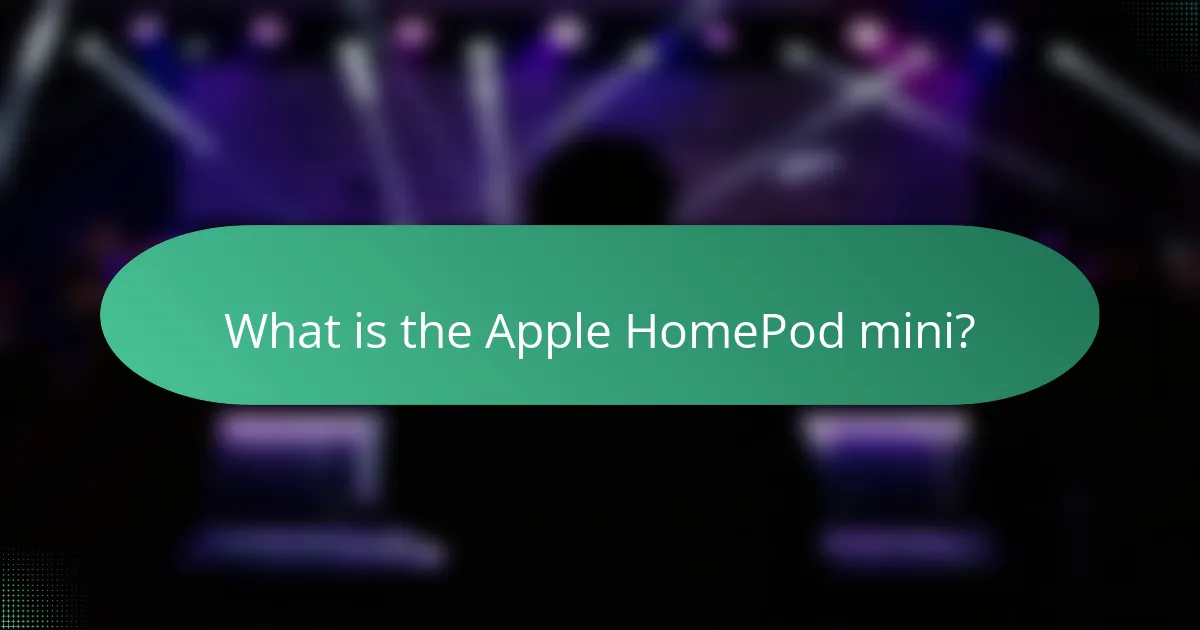The Apple HomePod mini is a compact smart speaker that integrates seamlessly with Apple devices, offering high-quality audio performance through advanced audio technology. Equipped with Siri, the device enables hands-free control and smart home management, while its sleek, modern design fits well in various home environments. Key features include multi-room audio capability, intercom functionality, and music sharing, enhancing the overall user experience. Released in November 2020, the HomePod mini reflects Apple’s commitment to innovative smart home technology and aesthetic simplicity. To optimize its use, users can connect it to the Apple ecosystem, leverage Siri for smart home control, and customize settings for improved performance.

What is the Apple HomePod mini?
The Apple HomePod mini is a compact smart speaker designed for seamless integration with Apple devices. It delivers high-quality audio performance through its advanced audio technology. The speaker features Siri, Apple’s voice assistant, for hands-free control and smart home management. Its design is sleek and modern, fitting well in various home environments. The HomePod mini supports multi-room audio and can be paired with other HomePod speakers for an enhanced listening experience. It also includes features like intercom and music sharing. The device was released in November 2020, showcasing Apple’s commitment to smart home technology.
How does the Apple HomePod mini fit into the smart speaker market?
The Apple HomePod mini is a compact smart speaker that competes in the mid-range segment of the smart speaker market. It offers high-quality audio performance with a 360-degree sound experience. The HomePod mini integrates seamlessly with Apple’s ecosystem, enhancing its appeal to existing Apple users. It features Siri for voice commands and smart home control. The device is priced competitively at $99, making it accessible compared to other premium smart speakers. Its design is aesthetically pleasing, available in multiple colors to fit various home decors. The HomePod mini’s focus on privacy and security aligns with growing consumer concerns in the smart device market. Overall, it positions itself as a versatile, user-friendly option for those seeking a smart speaker with strong audio capabilities and smart home integration.
What are the key features that define the Apple HomePod mini?
The Apple HomePod mini is defined by its compact design, high-quality audio, and smart home integration. It features a 360-degree sound experience, delivering rich audio in any direction. The device includes Siri voice assistant for hands-free control and smart home management. It supports Apple Music and other streaming services for wide audio access. HomePod mini utilizes intercom functionality for communication across devices. It is equipped with multiple microphones for voice recognition. The device also offers privacy features, including on-device processing for voice commands. Lastly, it has a sleek, modern design that fits various home aesthetics.
How does the Apple HomePod mini compare to its competitors?
The Apple HomePod mini offers superior integration with Apple devices compared to its competitors. It features seamless connectivity with iOS and macOS ecosystems. This integration enhances user experience through features like Handoff and AirPlay 2. In terms of audio quality, the HomePod mini provides 360-degree sound and adaptive audio tuning. Competitors like Amazon Echo and Google Nest Audio offer good sound but lack this level of optimization. The HomePod mini also supports Siri, which excels in smart home control within Apple’s ecosystem. While competitors provide broader third-party compatibility, they may not match the HomePod mini’s sound quality and user experience for Apple users.
What are the audio performance capabilities of the Apple HomePod mini?
The Apple HomePod mini delivers high-quality audio performance. It features a full-range driver and dual passive radiators. These components work together to produce deep bass and clear sound. The HomePod mini also uses computational audio technology. This technology optimizes sound quality based on the room’s acoustics. The speaker’s 360-degree audio design allows sound to fill the space evenly. It supports high-fidelity audio streaming from Apple Music. The HomePod mini also includes Siri integration for voice control. This combination enhances the overall audio experience.
How does the sound quality of the Apple HomePod mini measure up?
The sound quality of the Apple HomePod mini is impressive for its size. It features a full-range driver that delivers clear audio across various frequencies. The HomePod mini uses computational audio to enhance sound performance. This technology optimizes audio output in real-time. The device also has a 360-degree sound design, allowing for immersive listening experiences. Users report balanced bass and treble, making it suitable for diverse music genres. Additionally, the HomePod mini adapts to its environment for improved acoustics. Overall, it provides a high-quality sound experience in a compact form.
What audio technologies are utilized in the Apple HomePod mini?
The Apple HomePod mini utilizes advanced audio technologies including a full-range driver and passive radiators. These components work together to enhance sound quality and create a rich audio experience. The full-range driver delivers clear vocals and detailed sound. Passive radiators help to produce deeper bass tones. The HomePod mini also features computational audio technology. This technology optimizes sound based on the speaker’s environment. Additionally, the device supports spatial awareness for improved soundstage. These audio technologies contribute to the overall performance of the HomePod mini.
What smart features does the Apple HomePod mini offer?
The Apple HomePod mini offers several smart features. It includes Siri integration for voice commands and smart home control. Users can ask Siri to play music, set reminders, or control compatible devices. The HomePod mini supports multi-room audio for synchronized playback across multiple speakers. It also features Intercom functionality, allowing users to communicate between HomePod devices. The device supports Apple Music and other streaming services for easy access to content. Additionally, it can recognize different voices, providing personalized responses. The HomePod mini utilizes advanced computational audio for enhanced sound quality. These features contribute to its versatility as a smart speaker.
How does Siri enhance the functionality of the Apple HomePod mini?
Siri enhances the functionality of the Apple HomePod mini by providing voice-activated control and smart home integration. Users can issue commands to play music, set reminders, and control smart devices. Siri’s integration allows for seamless management of home automation, including lighting and temperature adjustments. The HomePod mini responds to voice queries, offering information such as weather updates and news. Siri also enables multi-room audio by coordinating playback across multiple devices. The device uses advanced natural language processing to understand commands accurately. This functionality is supported by Apple’s robust ecosystem, ensuring compatibility with various apps and services.
What smart home integrations are compatible with the Apple HomePod mini?
The Apple HomePod mini is compatible with a variety of smart home integrations. It works with HomeKit-enabled devices, allowing control of lights, locks, and thermostats. Popular brands include Philips Hue, Ecobee, and August. The HomePod mini also supports smart plugs and cameras. Users can control these devices using Siri voice commands. The integration enhances the convenience of managing a smart home ecosystem. Apple regularly updates compatibility with new devices and features.

What design aesthetics characterize the Apple HomePod mini?
The Apple HomePod mini is characterized by a sleek, minimalist design. It features a compact spherical shape that enhances its modern aesthetic. The fabric mesh exterior is available in multiple colors, adding to its visual appeal. The top of the device is a smooth, touch-sensitive surface. This surface displays a colorful light ring that indicates its status. The design prioritizes both form and function, ensuring it fits seamlessly into various environments. The overall aesthetic reflects Apple’s commitment to simplicity and elegance in product design.
How does the design of the Apple HomePod mini influence its usability?
The design of the Apple HomePod mini significantly enhances its usability. Its compact spherical shape allows for easy placement in various environments. The fabric mesh exterior not only looks aesthetically pleasing but also helps with sound diffusion. The touch controls on the top provide intuitive interaction for volume adjustment and playback. Its lightweight design facilitates portability, enabling users to move it with ease. The HomePod mini’s seamless integration with Apple devices enhances usability through features like voice commands via Siri. These design elements collectively contribute to a user-friendly experience.
What materials and colors are available for the Apple HomePod mini?
The Apple HomePod mini is made from a fabric mesh material and features a hard plastic base. It is designed to be both functional and aesthetically pleasing. The available colors for the HomePod mini are Space Gray, White, Blue, Yellow, and Orange. These color options allow for personalization to fit various home decors. The fabric mesh is designed for optimal sound quality while providing a modern look.
How does the size of the Apple HomePod mini affect its placement in a home?
The size of the Apple HomePod mini allows for versatile placement options in a home. Its compact design, measuring 3.3 inches in height and 4.0 inches in diameter, makes it easy to fit in various spaces. The small footprint enables it to be placed on shelves, countertops, or bedside tables without taking up much room. Additionally, its lightweight nature allows for easy relocation as needed. The aesthetic design complements modern decor, making it suitable for any room. Its size also means it can be positioned in multiple locations to enhance audio performance and smart features. Overall, the HomePod mini’s dimensions facilitate flexible integration into diverse home environments.
What are the user experiences and feedback regarding the Apple HomePod mini?
User experiences and feedback regarding the Apple HomePod mini are generally positive. Users appreciate its compact design and sound quality. Many highlight the rich bass and clear audio performance. The integration with Apple’s ecosystem is frequently praised. Users find it easy to set up and use with other Apple devices. However, some users note limitations in smart home compatibility. Feedback indicates a desire for more third-party app support. Overall, the HomePod mini is seen as a strong entry in the smart speaker market.
What do users appreciate most about the Apple HomePod mini?
Users appreciate the Apple HomePod mini for its impressive sound quality and compact design. The device delivers rich audio performance despite its small size. Many users highlight its ability to fill a room with sound. The integration with Apple’s ecosystem is also a significant benefit. Users value seamless connectivity with other Apple devices. The HomePod mini’s smart assistant capabilities enhance user experience. Voice recognition and Siri functionality receive positive feedback. Lastly, users commend its aesthetic appeal, which fits well in various home environments.
What common issues do users report with the Apple HomePod mini?
Common issues users report with the Apple HomePod mini include connectivity problems. Many users experience difficulties connecting to Wi-Fi networks. Some also report issues with Siri responsiveness. Users have noted that Siri sometimes misunderstands commands or fails to respond. Additionally, sound quality inconsistencies have been mentioned. Some users feel that bass performance is lacking. Moreover, users report concerns about limited third-party app integration. These issues impact overall user satisfaction and functionality.

How can you maximize the value of your Apple HomePod mini?
To maximize the value of your Apple HomePod mini, utilize its full range of features. Connect it to your Apple ecosystem for seamless integration. Use Siri for hands-free control of smart home devices. Stream music from Apple Music for high-quality audio. Take advantage of multi-room audio by pairing multiple HomePod minis. Customize settings in the Home app to enhance performance. Regularly update the software to access new features. These actions enhance functionality and improve user experience.
What tips can enhance your experience with the Apple HomePod mini?
To enhance your experience with the Apple HomePod mini, position it away from walls for optimal sound quality. This placement allows for better audio dispersion. Use the Home app to customize settings and control your smart home devices seamlessly. Regularly update the HomePod mini’s software to access new features and improvements. Experiment with different music services to find the best audio experience. Utilize multi-room audio to enjoy synchronized music throughout your home. Voice commands can control various functions, making usage more convenient. Finally, explore Siri’s capabilities for hands-free assistance and smart home management.
How can you optimize audio settings for the best performance?
To optimize audio settings for the best performance on the Apple HomePod mini, adjust the equalizer settings. Access the Home app on your iOS device. Select the HomePod mini and tap on “Settings.” Here, you can modify the equalizer to enhance sound quality. Enable the “Music” option for a balanced audio experience. Ensure the HomePod mini is placed in an optimal location for sound dispersion. Avoid placing it in corners or enclosed spaces. Update the device software regularly for performance improvements. These adjustments can significantly enhance audio clarity and overall performance.
What are the best practices for integrating the Apple HomePod mini into your smart home?
To integrate the Apple HomePod mini into your smart home, start by placing it in a central location for optimal sound and voice recognition. Connect the HomePod mini to your Wi-Fi network through the Home app on your iOS device. Utilize Siri for voice control of compatible smart home devices, enhancing convenience and accessibility. Group compatible devices in the Home app for easier management and automation. Set up routines to automate tasks, such as adjusting lights or playing music at specific times. Ensure your devices are compatible with Apple HomeKit for seamless integration. Regularly update the HomePod mini software for improved features and security. These practices enhance functionality and create a cohesive smart home experience.
The Apple HomePod mini is a compact smart speaker that integrates seamlessly with Apple devices, offering high-quality audio performance and smart home management through Siri. This review covers its key features, including 360-degree sound, multi-room audio capabilities, and a sleek design available in multiple colors. It also compares the HomePod mini with competitors in the smart speaker market, highlights its audio technologies, and discusses user experiences, common issues, and best practices for maximizing its value within a smart home ecosystem. Overall, the article provides a comprehensive overview of the HomePod mini’s audio performance, smart features, and design aesthetics.
